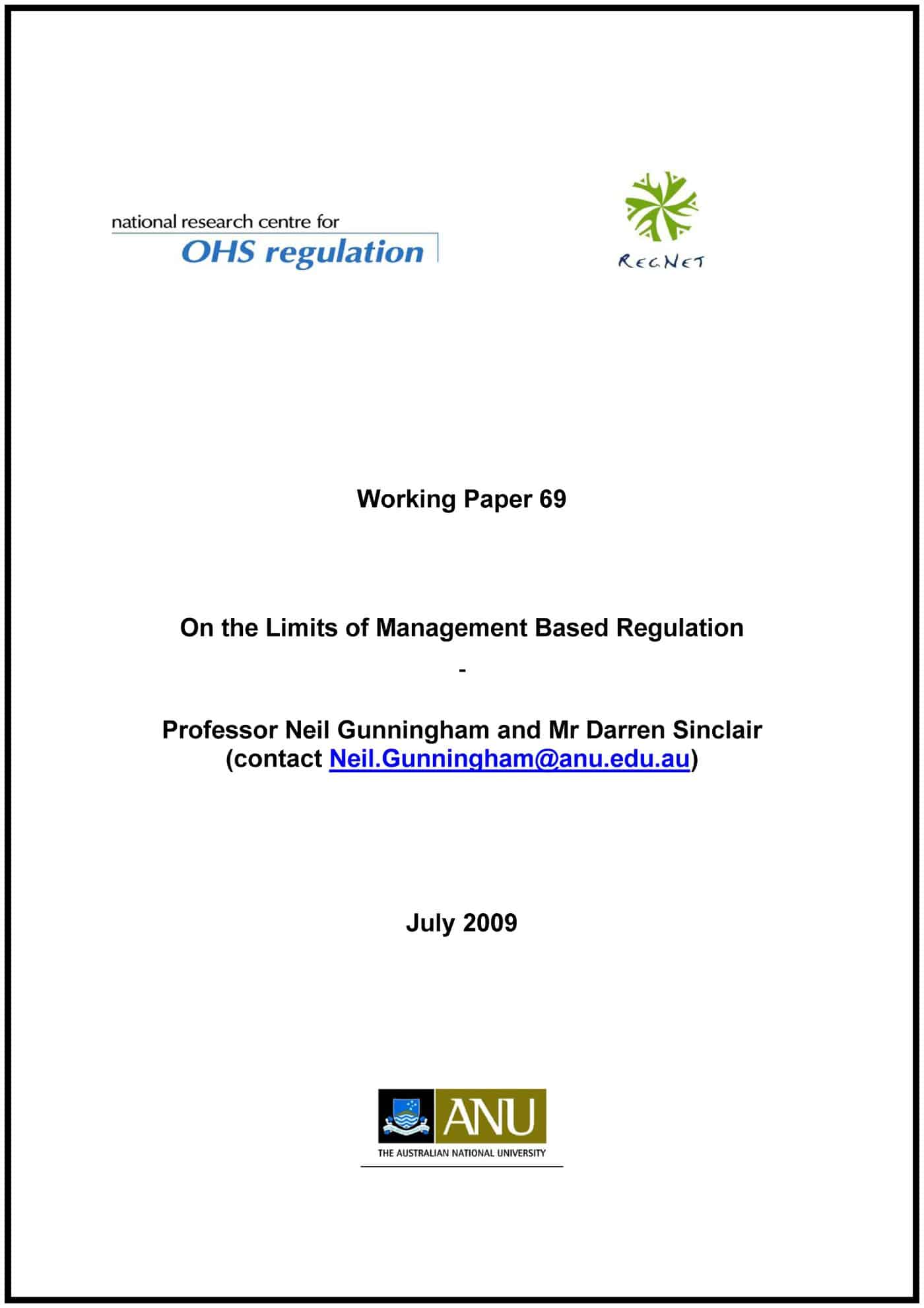The National Research Centre for Occupational Health and Safety Regulation at the Australian National University is one of the few Australian research centres who provide free access to their data. The number is growing but is still way behind institutions overseas.
 The latest research report they have released concerns management-based regulations as opposed to prescriptive regulations. Australia and many other countries have moved away from prescriptive OHS rules but this research by Neil Gunningham and Darren Sinclair has some good points on establishing workplace safety cultures by looking at a couple of case studies.
The latest research report they have released concerns management-based regulations as opposed to prescriptive regulations. Australia and many other countries have moved away from prescriptive OHS rules but this research by Neil Gunningham and Darren Sinclair has some good points on establishing workplace safety cultures by looking at a couple of case studies.
The abstract says
“The paper argues that notwithstanding the heavy emphasis currently being placed on both internal (company driven) and external (government driven) management-based regulation, a commitment at corporate level does not necessarily percolate down to individual facilities where ritualistic responses or resistant sub-cultures may thwart effective change. The findings have important implications for the effectiveness of management based regulation and meta-regulation more broadly.” (my emphasis)
The researchers go on to discuss the spread of shared values and shared meaning, how individuals and small units can thwart the good management intentions by a lack of organisational trust, through a literature review as well as the case studies and empirical data
For anyone who is the least bit interested in establishing a workplace safety culture, the following quote should get them downloading this report.
“Management based regulation does not ignore the challenges of engaging with group behavior. Indeed, its proponents assert that the capacity to achieve cultural change is one of its attributes (Welford 1997). But whether, to what extent, or in what circumstances this is the case remains a matter of conjecture. Certainly changing cultures is no easy matter and it may well be far more difficult for senior management to manipulate than many organizational theorists assume (Morgan 1986:139). Yet without cultural commitment on the part of those who are expected to implement the system, then edicts from regulators or (in the case of internal regulation) from senior management, may be met with creative compliance (McBarnet & Whelan 1999), resistance, “ritualism” (Merton 1968; Braithwaite 2008a:140-56) or various other forms of tokenism.”

Excellent post. Very true. Some times I feel that we get down in to systems aspects that the ground level operational aspects gets overlooked leading to potential adverse situation. The best system should be a mix of management systems+ self regulation through culture + Regulation at a broader level.
Of course, in these tough times, it is easily said than done.
Karthik
Bangalore, India.
Karthik
Yes it is easier said than done however safety management has existed through major economic fluctuations in the past and certainly through my own 30 years of labour.
There must be strategies that safety professionals have applied in past downturns that could be applicable now but I have not heard of any yet. This may be because safety management has been (justifiably) distracted by job insecurity or it may be due to a conscious business decision to \”stall\” safety initiatives until there are economic positives.
I would love to know of anyone who is researching how companies (if any) have maintained safety programs during the recession.
Thea
Thanks for reading the ANU papers. They have always been a good source of research and discussion.
You may be interested in knowing that Standards Australia has been heavily affected by the global economic crisis and is investigating alternative business models. This has occurred at the same time that the influence of international standards is increasing in Australia.
With such a comparatively small manufacturing sector and an increasing economic reliance on Asia, standards specifically deisgned for Australia may be losing relevance and viability.
I really enjoyed reading this paper – so much so I wrote a blog post about it on my blog at http://www.ohsas18001expert.com.
I think the authors have pointed out a number of the problems associated with relying on corporate standards without addressing important organizational and culture issues such as lack of trust and divided loyalties. I do continue to think that management system standards, as well as internal corporate standards, play an important role in improving occupational safety and health; however, this paper convinced me to re-examine the importance of trust in establishing a safety culture.
If you believe Australia\’s moved away from prescriptive rules, take a read of the NSW Occupational Health and Safety Regulation. It\’s about as prescriptive as they come – it even has specific regulations for demolishing a chimney stack.